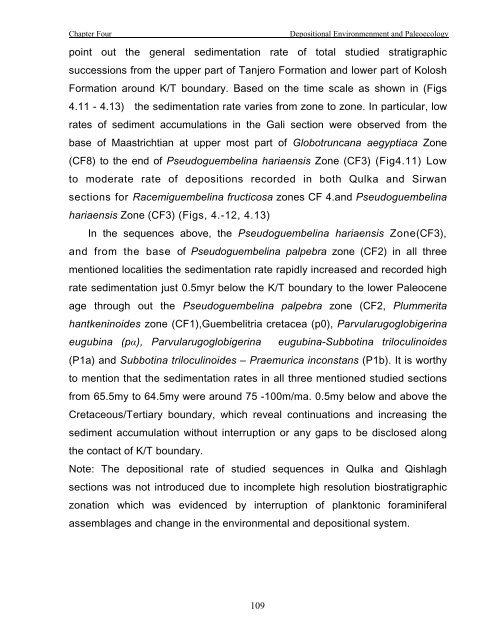biostratigraphy and paleoecology of cretaceous/tertiary boundary in ...
biostratigraphy and paleoecology of cretaceous/tertiary boundary in ...
biostratigraphy and paleoecology of cretaceous/tertiary boundary in ...
You also want an ePaper? Increase the reach of your titles
YUMPU automatically turns print PDFs into web optimized ePapers that Google loves.
Chapter Four<br />
Depositional Environmenment <strong>and</strong> Paleoecology<br />
po<strong>in</strong>t out the general sedimentation rate <strong>of</strong> total studied stratigraphic<br />
successions from the upper part <strong>of</strong> Tanjero Formation <strong>and</strong> lower part <strong>of</strong> Kolosh<br />
Formation around K/T <strong>boundary</strong>. Based on the time scale as shown <strong>in</strong> (Figs<br />
4.11 - 4.13) the sedimentation rate varies from zone to zone. In particular, low<br />
rates <strong>of</strong> sediment accumulations <strong>in</strong> the Gali section were observed from the<br />
base <strong>of</strong> Maastrichtian at upper most part <strong>of</strong> Globotruncana aegyptiaca Zone<br />
(CF8) to the end <strong>of</strong> Pseudoguembel<strong>in</strong>a hariaensis Zone (CF3) (Fig4.11) Low<br />
to moderate rate <strong>of</strong> depositions recorded <strong>in</strong> both Qulka <strong>and</strong> Sirwan<br />
sections for Racemiguembel<strong>in</strong>a fructicosa zones CF 4.<strong>and</strong> Pseudoguembel<strong>in</strong>a<br />
hariaensis Zone (CF3) (Figs, 4.-12, 4.13)<br />
In the sequences above, the Pseudoguembel<strong>in</strong>a hariaensis Zone(CF3),<br />
<strong>and</strong> from the base <strong>of</strong> Pseudoguembel<strong>in</strong>a palpebra zone (CF2) <strong>in</strong> all three<br />
mentioned localities the sedimentation rate rapidly <strong>in</strong>creased <strong>and</strong> recorded high<br />
rate sedimentation just 0.5myr below the K/T <strong>boundary</strong> to the lower Paleocene<br />
age through out the Pseudoguembel<strong>in</strong>a palpebra zone (CF2, Plummerita<br />
hantken<strong>in</strong>oides zone (CF1),Guembelitria cretacea (p0), Parvularugoglobiger<strong>in</strong>a<br />
eugub<strong>in</strong>a (pá), Parvularugoglobiger<strong>in</strong>a eugub<strong>in</strong>a-Subbot<strong>in</strong>a trilocul<strong>in</strong>oides<br />
(P1a) <strong>and</strong> Subbot<strong>in</strong>a trilocul<strong>in</strong>oides – Praemurica <strong>in</strong>constans (P1b). It is worthy<br />
to mention that the sedimentation rates <strong>in</strong> all three mentioned studied sections<br />
from 65.5my to 64.5my were around 75 -100m/ma. 0.5my below <strong>and</strong> above the<br />
Cretaceous/Tertiary <strong>boundary</strong>, which reveal cont<strong>in</strong>uations <strong>and</strong> <strong>in</strong>creas<strong>in</strong>g the<br />
sediment accumulation without <strong>in</strong>terruption or any gaps to be disclosed along<br />
the contact <strong>of</strong> K/T <strong>boundary</strong>.<br />
Note: The depositional rate <strong>of</strong> studied sequences <strong>in</strong> Qulka <strong>and</strong> Qishlagh<br />
sections was not <strong>in</strong>troduced due to <strong>in</strong>complete high resolution biostratigraphic<br />
zonation which was evidenced by <strong>in</strong>terruption <strong>of</strong> planktonic foram<strong>in</strong>iferal<br />
assemblages <strong>and</strong> change <strong>in</strong> the environmental <strong>and</strong> depositional system.<br />
109

















